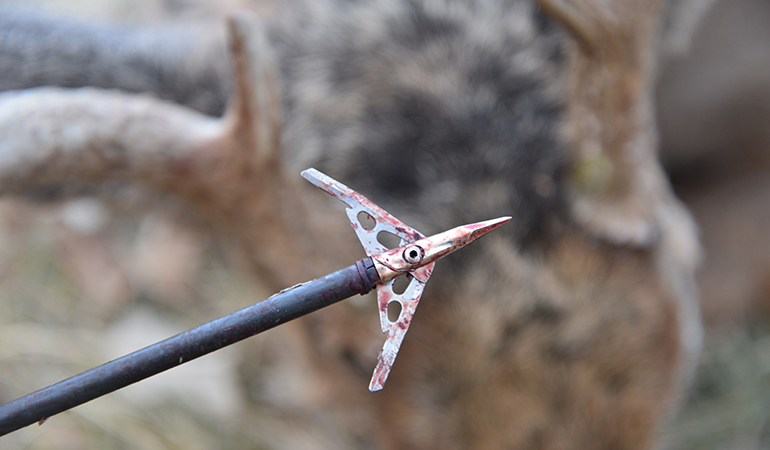
About 10 years ago, I was tucked into the edge of a winter rye field on public land in the suburbs of the Twin Cities. I was looking for a deer – any deer – and when that deer stepped out and start feeding my way, I ranged her. When she turned broadside, I 10-ringed her.
As the doe ran off, I watched and waited but the lights didn’t go out. When I found my arrow, it was laying in the field and the grooves in each blade of the mechanical broadhead that allowed them to fully open on impact were jammed full of deer hair. There was a bit of blood on the very tip, but by all of the evidence I could find, my arrow – which should have been capable of a pass-through on a bull moose – had bounced off of a whitetail doe.
A few years later, I shot a solid whitetail buck and watched my arrow stick into his side as if I’d shot an oak door. When I found the broken shaft, I could hear the broken ferrule rattle around inside the insert. That broadhead was a fixed blade model that couldn’t have been more different from the mechanical from the previous season.
The common ground they shared was that they both failed.
Broadhead Design & Materials
Mechanical or expandable heads have come a long way since they started becoming popular. There have been a pile of designs that were laughable, but unfortunately, bowhunters bought them and shot animals with them. Broadheads with moving parts don’t hold the monopoly on poor designs or their in-field usage, either. We’ve witnessed marketing-dollar backed heads that weren’t qualified to be used on squirrels, let alone deer.

The reality is that broadhead choice matters, and when it comes to deer you’d be well-served to consider what head you choose and why. For starters, take a look at your potential choices. How are they designed to cut? That might seem simple, but it matters. For me, curved or serrated blades are out. I like straight blades that are wicked sharp no matter what kind of broadhead they’re on.
With mechanicals, I like broadheads that open by allowing the trailing edge to move back and into place as opposed to the jackknife style that has to open from the front. If I’m going to use a broadhead with moving parts, I want those movements to be minimal and in line with physics as much as possible.
No matter your choice, don’t bargain shop. Good materials cost money, and if you’re buying broadheads for $5 a head, you’re buying junk. They might work, but they might not and this is not the part of bowhunting where you should cheap out. You need a broadhead to function and to get the cost down to the price of a Starbuck’s iced latte, you’ve got to make too many sacrifices on materials and design.
Broadhead Cutting Diameter & Surface
The argument for mechanicals is they offer larger cutting diameters than fixed heads, which means when you grass-bag a buck instead of hitting lungs, you’ve got a higher chance of recovery. This is generally true, and a solid check in the plus column. That same 2-inch cutting diameter head won’t get through a shoulder very easily, however. A good fixed blade on the other hand – one designed with a much smaller cutting diameter – might.
Pay attention to cutting diameter but also cutting surface. A compact three- of four-blade fixed head might offer more cutting surface than you’d think, and in my experience, the four-blade options are pretty amazing when it comes to creating nasty blood trails.

If you’re a northern Wisconsin bowhunter where bucks could breach 200 pounds on the hoof without even trying, you might be better off with the fixed head. If you’re a southern Oklahoma hunter who won’t deal with an oversized skeletal structure, mechanicals might be a better bet. It’s all situational.
Broadhead Flight Time
I’ve never had a well-tuned bow that wouldn’t shoot all kinds of broadheads with my field points. I have, however, had poorly-tuned bows that wouldn’t shoot fixed heads, and even some mechanicals, very well. If your bow is throwing knuckleballs, you can mask some of that performance with a smaller in-flight head like a mechanical. But that’s a bad idea.
Clean your tuning house first and then decide what broadhead is best for your hunting situation. You don’t want to use a specific head simply because it’ll act as some sort of Bandaid either because you can’t shoot very well, or your rig is off.
Conclusion
The debate won’t end, and maybe it shouldn’t. It’s a good thing that we are passionate about our broadhead choice, because it (hopefully) means we are considering our options. That’s what we should be doing, and we should be basing our choice on individual hunting scenarios and what our research tells us about how broadheads are made and designed. If we choose wisely, we tip the odds in our favor when we step into the woods and that matters – a lot.











































![Air gun 101: The differences between .177 & .22 – Which jobs they do best ? [Infographic]](https://airgunmaniac.com/wp-content/uploads/2020/09/g44-150x150.jpg)



